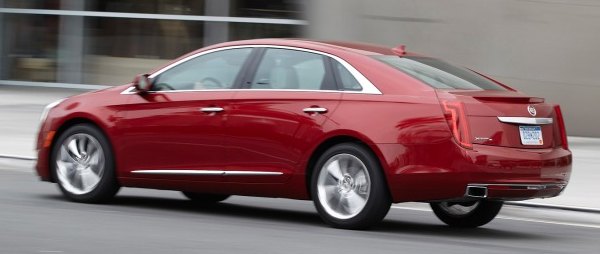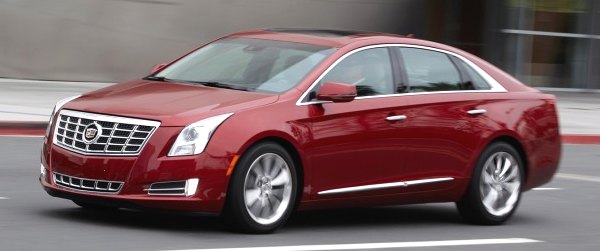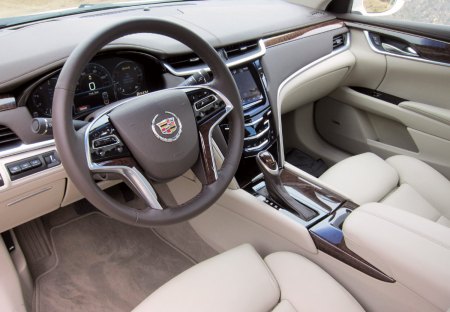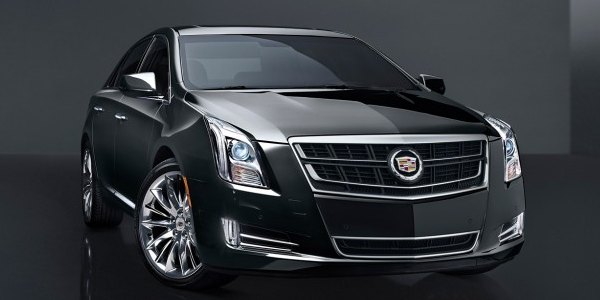|
|
|
| Published
on 12
Apr
2012 |
All rights reserved.
|
|
|
Until
the early 1960s Cadillac was still regarded as the standard of luxury
cars. Since then its fortune fell like a roller coaster. By the time I
started watching cars in the mid-1980s, Cadillac was the symbol of
outdated looking, low-tech and poorly finished American dinosaurs.
Still, it had a complete lineup of luxury cars – Cimarron, Seville,
DeVille / Fleetwood, Brougham, Eldorado and Allante – and a
self-respect that it could rival anything from BMW 3-Series to Mercedes
S-class and SL (it couldn't, of course). Consistently losing market
share and money, it started getting realistic in the new millennium.
Models that did not sell well were given a second chance (SeVille
became rear-drive STS; Allante was reborn as XLR) and
then killed off. Old-school DeVille / DTS went to grave together with
its equally old buyers. Rationalization was the number one job when GM
ran into bankruptcy. Suddenly, Cadillac found only CTS is left in its
showrooms!
Just before its bankruptcy, GM planned to replace both DTS and STS with
a single large car called XTS. Survival-mode thinking means the car is
not going to be an ambitious project. It would be built on the
low-cost, mid-size, front-wheel-drive Epsilon II platform that
underpins Opel Insignia. To pretend to be a big car, its wheelbase
would be stretched to the maximum 2837 mm like Buick LaCrosse (another
derivative of this platform). That is still not big enough though, so
it would lengthen the trunk further to realize a Cadillac-worthwhile
body length of 5.1 meters. The same realistic thinking also called for
the use of off-the-shelf parts, including engine, transmission and
suspension – hardly sounds "the standard of the world". Unfortunately,
the development program was disrupted for a year during the bankruptcy,
so the production XTS is just arriving the market in June 2012.
 |
The
first
glance at the car immediately reveals its cheap underpinnings. Its
short bonnet and cab-forward profile are unmistakably the signs of a
front-wheel-drive, transverse-engined platform. That doesn't sound
amusing for a car whose price matches or exceeds that of Mercedes
E-class, Audi A6 or BMW 5-Series. But more problematic is aesthetic.
With a short bonnet and an unnaturally long tail, its proportion is
weird. The combination of a high waist line, non-existent shoulders and
a tall (1510 mm) roof leads to a perception of narrowness and
overweight, thus amplifies its poor dynamics even further. The
proportion is so wrong that any nice details and heavy use of chromes
cannot compensate.
The XTS tips the scale at 1815 kg in FWD form or 1910 kg with Haldex
4WD system. Those numbers exceed the class average by 100 and 200 kg
respectively. It certainly needs a more powerful engine. Unfortunately,
since the demise of Northstar GM no longer has any V8s suitable for
luxury car applications – the pushrod small-blocks generate too much
NVH, so they are left to SUVs and performance cars – as a result, the
XTS has to settle with the familiar 3.6-liter direct-injected V6.
Practically the same engine powering the smaller CTS but turned to
mount transversely, the all-alloy DVVT V6 produces 304 horsepower,
accompanied with a slightly peaky 264 lbft of torque. It is every bit
competitive against the likes of Toyota's or Honda's V6s, but when
compare with the higher tech, better engineered BMW, Audi and Mercedes
six-cylinder engines (let alone V8s), it is apparently short of torque
and refinement. Likewise, GM's 6-speed automatic is not as seamless and
responsive as its rivals' 7 or 8-speed units. In addition to the
heavier body, you need to wind the engine hard to get a decent turn of
speed. Using the manual mode's paddle shift might help a little, but
that goes against the intent of driving a big luxury car.
 |
Considering its platform basis and its heft, the XTS handles and rides
better than imagined. This is partly due to the use of OPC-engineered
HiPer struts instead of the usual MacPherson struts for the front
suspension, which largely eliminates torque steer. Even more
contribution is made by the advanced magnetorheological adaptive
dampers (or "Magnetic Ride Control") fitted to the car. It results in a
smooth yet controlled ride, which is not only million miles better than
Buick LaCrosse' but also a match for its best rivals. A quick, 2.6
turns lock-to-lock steering ratio and old-school hydraulic servo return
honest feel and good response. The Brembo front brakes do a good job to
stop the car, too. That said, the XTS does feel nose-heavy in tight
corners, where it arrives terminal understeer early. There is no way to
deceive the law of physics.
The Haldex AWD option shows no discernible difference in this respect,
although its rear differential has torque vectoring function (note:
it's a Haldex Gen IV system like the XWD on late Saab 9-3). As always,
the Haldex system sends torque to rear axle only when the front wheels
slip, therefore the torque vectoring's ability to correct understeer
does not happen when the car is within limit of adhesion. As Cadillac
admitted, the superiority of AWD model can be found in slippery
conditions only.
Cadillac is very proud of its interior. In the top-spec Platinum trim,
all surfaces are covered with expensive materials like leather, wood
and alloy. Soft-touch plastic takes a less significant role than the
cases on its German rivals, so in terms of material richness this cabin
is unrivalled. Nevertheless, the interior design is a little dull to
look at. It also lacks a unified theme, which means it looks as if a
summation of quality parts instead of a masterpiece sculpture.
 |
Cabin
room is
huge. Thanks to the FF layout, the XTS uses its wheelbase very
efficiently to benefit cabin space. Rear passengers should enjoy
considerably more legroom here than on its German rivals – actually,
even more than a standard-wheelbase 7-Series. The only downside is
there is no space for feet under the front seats.
Apart from interior, an infotainment system called CUE (Cadillac User
Experience) is supposed to be another highlight of the car. It uses an
8-inch capacitive touch screen in place of virtually all buttons in the
cabin to control air-con, audio, radio, sat-nav, phone and OnStar
telematics. You access it like using iPad, i.e. by pressing, tapping
and sweeping, or alternatively by voice commands (though the
recognition is not always correct), so it seems to be easier to use
than i-Drive, MMI and COMAND. It costs less to build, too, as it uses
only an industrial standardized touch screen instead of any bespoke
hardware. Unfortunately, this approach is far too radical to the
traditional customers of Cadillac, who are probably too old to get
comfortable with new technologies. They will hate the need to press the
screen several times just to adjust the air-con or switch to another
radio station. Moreover, the icons are too small for old eyes, and the
users have to distract vision from the road to the screen. German
manufacturers have already learned from past mistakes and added
physical buttons for such frequently used functions. Sadly, Cadillac
failed to learn from them.
All these big and small problems mean the XTS is not going to
turnaround Cadillac as its maker hoped. The market has plenty of luxury
cars that offer stronger performance, rear-drive dynamics and stylish
looks. Some are even cheaper. The Cadillac's strengths are rather
limited in comparison. I don't see many people would forgo the
establishment and turn to the Cadillac. |
Verdict:    |
Published
on 26
Aug 2013
|
All rights reserved.
|
|
XTS Vsport twin-turbo V6
|
|

|
Since the introduction of
small-block V8, General Motors had been renowned for offering V8 engine
options on just about every model it built. Ridiculously, today the
firm no longer offers any V8s for its large cars, blame to the cost
cutting and bankruptcy taking place in the past few years. Most telling
is the mismatch of Cadillac XTS and a naturally aspirated 3.6-liter V6.
It is an underpowered, strange and disgraceful combination. Now GM is
in a much better shape, but seeing the market trend of downsizing
engines it decided to skip the V8 route and develop a twin-turbo
version of the V6 instead. By the way, this also saves a great deal of
money.
Hidden under the ugly plastic cover is the compact intercooler, which
connects to two small turbos through short pipes and a single
electronic throttle. Turbo lag is minimized further by closely coupling
the turbos to the exhaust manifolds. Like the naturally aspirated
version, it is fed by direct injection and continuous variable valve
timing. The latter utilizes large valve overlapping to generate
scavenging effect, spooling up the turbos more quickly. With a max.
boost pressure of 0.8 bar, the engine produces an additional 100
horsepower and 100 pound-foot of torque (now 410 hp and 369 lbft), far
more powerful than the turbo six engines that its German rivals employ.
Even though the car weighs as much as 2 tons, it can sprint from rest
to 60
mph in just over 5 seconds. No one can complain for lack of performance
anymore.
Nevertheless, the rest of the resultant XTS Vsport is nowhere as hot as
its name suggested. Its 6-speed automatic transmission (carried over
from the regular car) is not enthusiastic enough. Its suspension,
steering and brakes are also carried over from the NA model, no wonder
it feels too soft and bulky for a car with such straight line
performance. The 4-wheel-drive system and HiPer strut front suspensions
fail to mask the torque steer completely if you are hurry in corners.
As a result, it shall be seen as an XTS with added punch rather
than a sports saloon. Yes, the extra power has answered one of our main
criticisms of the XTS, but the ugly look and annoying CUE control
remain. Moreover, its price has elevated to an uncomfortable level. I
wonder how many American people, even the patriotic ones, would choose
this car over Mercedes, BMW, Audi or Lexus.
|
Verdict:    |
|
|
|
|
|
|
|
|
|
|
XTS 3.6
|
2012
|
| Front-engined,
FWD |
| Steel monocoque |
| Mainly steel |
| 5130 / 1852 / 1510 mm |
| 2837 mm |
V6, 60-degree
|
| 3564 cc |
DOHC 24 valves, DVVT
|
| - |
| DI |
304 hp
|
264 lbft
|
| 6-speed automatic |
F: HiPer strut
R: multi-link
|
Adaptive damping
|
245/40R20
|
1815 kg
|
136 mph (limited)
|
6.8 (c) / 6.9* / 6.6*
|
17.9* / 16.9*
|
|
XTS 3.6 AWD
|
2012
|
| Front-engined,
4WD |
| Steel monocoque |
| Mainly steel |
| 5130 / 1852 / 1510 mm |
| 2837 mm |
V6, 60-degree
|
| 3564 cc |
DOHC 24 valves, DVVT
|
| - |
| DI |
304 hp
|
264 lbft
|
| 6-speed automatic |
F: HiPer strut
R: multi-link
|
Adaptive damping
|
245/40R20
|
1910 kg
|
136 mph (limited)
|
6.8 (c) / 7.2*
|
18.6*
|
|
XTS Vsport AWD
|
2013
|
| Front-engined,
4WD |
| Steel monocoque |
| Mainly steel |
| 5130 / 1852 / 1510 mm |
| 2837 mm |
V6, 60-degree
|
| 3564 cc |
DOHC 24 valves, DVVT
|
| Twin-turbo |
| DI |
410 hp
|
369 lbft
|
| 6-speed automatic |
F: HiPer strut
R: multi-link
|
Adaptive damping
|
245/40R20
|
2010 kg
|
136 mph (limited)
|
5.2*
|
12.4*
|
|
|
|
|
|
Performance
tested by: *C&D
|
|
|
|
|
|
|
|
|
Copyright©
1997-2013
by Mark Wan @ AutoZine
|
|